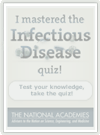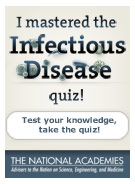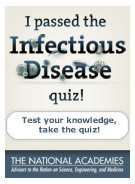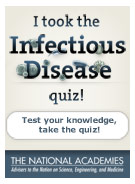
What You Need To Know About Infectious Disease
What do you know about infectious disease?
Which are examples of ways that pathogens (disease-causing microbes) can spread?
- Coughing
- Eating undercooked pork
- Flea bite
- Breathing dust particles containing microorganisms
- All of the above
-
Sorry, that’s incorrect.
All are examples of ways that pathogens can spread. Coughing is an example of airborne droplet transmission; eating undercooked pork is an example of common vehicle transmission; a flea bite is an example of vector transmission; and breathing contaminated dust particles is an example of airborne transmission.
-
Sorry, that’s incorrect.
All are examples of ways that pathogens can spread. Coughing is an example of airborne droplet transmission; eating undercooked pork is an example of common vehicle transmission; a flea bite is an example of vector transmission; and breathing contaminated dust particles is an example of airborne transmission.
-
Sorry, that’s incorrect.
All are examples of ways that pathogens can spread. Coughing is an example of airborne droplet transmission; eating undercooked pork is an example of common vehicle transmission; a flea bite is an example of vector transmission; and breathing contaminated dust particles is an example of airborne transmission.
-
Sorry, that’s incorrect.
All are examples of ways that pathogens can spread. Coughing is an example of airborne droplet transmission; eating undercooked pork is an example of common vehicle transmission; a flea bite is an example of vector transmission; and breathing contaminated dust particles is an example of airborne transmission.
-
Correct!
All are examples of ways that pathogens can spread. Coughing is an example of airborne droplet transmission; eating undercooked pork is an example of common vehicle transmission; a flea bite is an example of vector transmission; and breathing contaminated dust particles is an example of airborne transmission.
Which of the following is NOT a vector-borne disease?
-
Correct!
Influenza is not a vector-borne disease, meaning it is not transmitted to humans indirectly via an insect, an arthropod, or another animal. Malaria and yellow fever are transmitted by mosquitoes. Lyme disease is transmitted by deer ticks.
-
Sorry, that’s incorrect.
Influenza is not a vector-borne disease, meaning it is not transmitted to humans indirectly via an insect, an arthropod, or another animal. Malaria and yellow fever are transmitted by mosquitoes. Lyme disease is transmitted by deer ticks.
-
Sorry, that’s incorrect.
Influenza is not a vector-borne disease, meaning it is not transmitted to humans indirectly via an insect, an arthropod, or another animal. Malaria and yellow fever are transmitted by mosquitoes. Lyme disease is transmitted by deer ticks.
-
Sorry, that’s incorrect.
Influenza is not a vector-borne disease, meaning it is not transmitted to humans indirectly via an insect, an arthropod, or another animal. Malaria and yellow fever are transmitted by mosquitoes. Lyme disease is transmitted by deer ticks.
About how often is someone in the world newly infected with tuberculosis (TB)?
-
Correct!
Someone in the world is newly infected with tuberculosis (TB) every second. In 2008 there were an estimated 9.4 million new cases of tuberculosis and 1.8 million deaths.The vast majority of TB deaths are in the developing world, and more than half of all deaths occur in Asia.
-
Sorry, that’s incorrect.
Someone in the world is newly infected with tuberculosis (TB) every second. In 2008 there were an estimated 9.4 million new cases of tuberculosis and 1.8 million deaths.The vast majority of TB deaths are in the developing world, and more than half of all deaths occur in Asia.
-
Sorry, that’s incorrect.
Someone in the world is newly infected with tuberculosis (TB) every second. In 2008 there were an estimated 9.4 million new cases of tuberculosis and 1.8 million deaths.The vast majority of TB deaths are in the developing world, and more than half of all deaths occur in Asia.
True or False: Not all microbes are harmful to humans.
-
Correct!
Not all microbes are harmful to humans. In fact, many of them protect us, helping our bodies function properly and competing with harmful organisms in an eternal contest for habitable space in or on our bodies. Although the microorganisms that cause disease often receive more attention, most microorganisms do not cause illness.
-
Sorry, that’s incorrect.
Not all microbes are harmful to humans. In fact, many of them protect us, helping our bodies function properly and competing with harmful organisms in an eternal contest for habitable space in or on our bodies. Although the microorganisms that cause disease often receive more attention, most microorganisms do not cause illness.
About what percentage of the antibiotics produced in the United States is added to animal feeds to promote growth?
-
Sorry, that’s incorrect.
Almost 70% of all the antibiotics produced in the United States is added to animal feeds—not to fend off disease but to boost growth. These non-therapeutic uses of antibiotics are a perfect way to cultivate microbes that are resistant to antibiotics.
-
Sorry, that’s incorrect.
Almost 70% of all the antibiotics produced in the United States is added to animal feeds—not to fend off disease but to boost growth. These non-therapeutic uses of antibiotics are a perfect way to cultivate microbes that are resistant to antibiotics.
-
Correct!
Almost 70% of all the antibiotics produced in the United States is added to animal feeds—not to fend off disease but to boost growth. These non-therapeutic uses of antibiotics are a perfect way to cultivate microbes that are resistant to antibiotics.
How many people in the world do not have access to an adequate water supply?
-
Sorry, that’s incorrect.
Worldwide, 884 million people do not have access to an adequate water supply, and about three times that number lack basic sanitation services. An estimated 2 million deaths a year can be attributed to unsafe water supplies.
-
Sorry, that’s incorrect.
Worldwide, 884 million people do not have access to an adequate water supply, and about three times that number lack basic sanitation services. An estimated 2 million deaths a year can be attributed to unsafe water supplies.
-
Correct!
Worldwide, 884 million people do not have access to an adequate water supply, and about three times that number lack basic sanitation services. An estimated 2 million deaths a year can be attributed to unsafe water supplies.
True or False: Most infectious diseases are not impacted by changes in the environment.
-
Sorry, that’s incorrect.
Most infectious diseases are impacted by changes in the environment. Malaria, dengue, and viral encephalitis infections, for example, are highly sensitive to environmental changes.
-
Correct!
Most infectious diseases are impacted by changes in the environment. Malaria, dengue, and viral encephalitis infections, for example, are highly sensitive to environmental changes.
For which of the following diseases do we currently lack an effective vaccine for prevention?
-
Sorry, that’s incorrect.
Although there are treatments available in the form of antivirals, we still currently lack a vaccine for HIV.
-
Sorry, that’s incorrect.
Although there are treatments available in the form of antivirals, we still currently lack a vaccine for HIV.
-
Correct!
Although there are treatments available in the form of antivirals, we still currently lack a vaccine for HIV.
-
Sorry, that’s incorrect.
Although there are treatments available in the form of antivirals, we still currently lack a vaccine for HIV.
Due in large measure to the toll of infectious diseases, the gap in life expectancy between the richest and poorest countries now exceeds how many years?
-
Sorry, that’s incorrect.
The gap in life expectancy between the richest and poorest countries now exceeds 40 years.
-
Sorry, that’s incorrect.
The gap in life expectancy between the richest and poorest countries now exceeds 40 years.
-
Correct!
The gap in life expectancy between the richest and poorest countries now exceeds 40 years.
-
Sorry, that’s incorrect.
The gap in life expectancy between the richest and poorest countries now exceeds 40 years.
Thank you for taking our quiz.
Place this badge on your Facebook page to show your friends what you know about infectious disease.
Place this badge on your Facebook page to show your friends what you know about infectious disease.
OR, get a higher score to unlock a different badge.

Place this badge on your Facebook page to show your friends what you know about infectious disease.
OR, get a higher score to unlock a different badge.

Explore Other Topics
Disease Watchlist
Infectious Disease Defined
- Bronchial Tubes
Large tubes that carry air into smaller branches of the lungs after the air has passed through the mouth, nasal passages, and windpipe.


